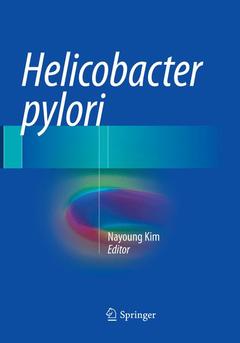Helicobacter pylori, 2016
Coordonnateur : Kim Nayoung

This book presents the current state of knowledge regarding the ability of Helicobacter pylori to colonize the gastrointestinal tract, the global epidemiology of H. pyloriinfection, transmission routes, the pathophysiology of H. pylori-related gastroduodenal and other diseases, diagnosis and treatment methods, guidelines for eradication, antibiotic resistance, the reinfection rate after H. pylori eradication, and animal models of H. pylori or related Helicobacter infection. The aim is to equip readers around the world with the understanding required in order to implement effective methods of H. pylori eradication and to enhance clinical outcomes for patients. The text is clearly written and is complemented by many helpful illustrations. This book will be a great asset in clinical practice for all practitioners who are involved in caring for patients with H. pylori-related diseases or have an interest in the subject. It will also be a useful source of information for medical students and for intelligent laypeople seeking information on H. pylori.
Part 1. Epidemiology-Prevalence and Transmission routes of H. pylori.- Part 2. Pathophysiology.- 1) Colonization of H. pylori in the stomach.- 2) Brief description of Pathophysiology.- 3) Immune mechanism.- 4) Change of acid secretion, ghrelin and leptin by H. pylori.- 5) H. pylori virulence factors.- A: toxin (CagA, VacA, DupA, OipA, IceA).- B: genetic polymorphism of toxin and disease.- 6) Host factors: genetic polymorphism, etc.- Part 3. Diagnosis.- 1) Serology.- 2) Histology.- 3) Culture.- 4) UBT.- 5) Stool antigen.- 6) Specific conditions.- A: Children.- B: Bleeding.- Part 4. Symptom.- 1)Symptom of acute and chronic H. pylori infection.- Part 5. Disease.- 1) Atrophic gastritis and Intestinal metaplasia.- 2) Functional dyspepsia.- 3) Peptic ulcer.- 4) MALToma.- 5) Gastric cancer.- A: Synopsis and Epidemiology of gastric cancer.- B1: Pathogenesis: i.Genetic alternation (mutations in tumor-related genes) induced by Activation-induced cytidine deaminase (AID).- B2: Pathogenesis: ii. Epigenetic mechanisms: aberrant DNA methylation, microRNA.- B3: Pathogenesis:iii. Macrophage inhibitory factor (MIF).- B4: Pathogenesis: iv. Epidermal mesenchyme transition (EMT).- B5: Pathogenesis: v. ABO blood type.- B6: Pathogenesis: vi. First relatives of gastric cancer.- C: H. pylori-negative gastric cancer.- 6) Gastroesophageal reflux disease (GERD).- 7) NSAID-induced gastropathy and H. pylori infection.- 8) Extraintestinal manifestations of H. pylori infection.- A: Iron deficiency anemia.- B: Idiopathic thrombocytopenic purpura.- C: Heart disease.- D: Atopy and allergy.- Part 6. Antibiotic resistance.- 1) Synopsis of antibiotic resistance.- 2) Clarithromycin.- 3) Amoxicillin.- 4) Quinolone.- 5) Metronidazole.- Part 7. Treatment.- 1) Synopsis of antibiotic treatment.- 2) Triple therapy.- 3) Quadruple therapy.- 4) Sequential therapy.- 5) Concomitant therapy.- 6) Tailored therapy based on antibiotic resistance.- 7) Levofloxacin or rifabutin based triple therapy.- 8) Probiotics.- 9) Treatment guidelines.- 10) Screening method of early gastric cancer.- 11) Recrudescence and reinfection.- Part 8. Consequences of H. pylori eradication.- 1) Peptic ulcer disease.- 2) atrophic gastritis and Intestinal metaplasia.- 3) Gastric cancer.- Part 9. The effect of H. pylori on the other microbiota of stomach.- The effect of H. pylori on the other microbiota of stomach.- Part 10. Animal model- H. pylori, H. felis.
Date de parution : 12-2018
Ouvrage de 556 p.
17.8x25.4 cm
Date de parution : 10-2016
Ouvrage de 556 p.
17.8x25.4 cm
Disponible chez l'éditeur (délai d'approvisionnement : 15 jours).
Prix indicatif 232,09 €
Ajouter au panier


